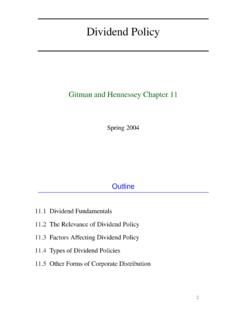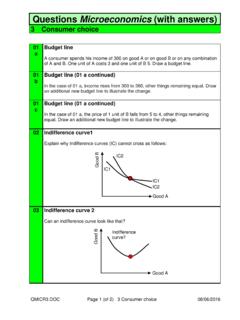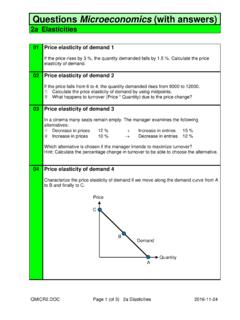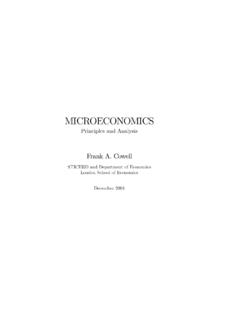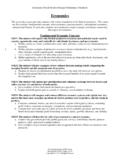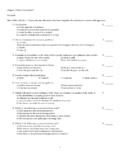Transcription of ECON 5113 Advanced Microeconomics - Lakehead University
1 ECON 5113 Advanced Microeconomics Winter 2019. answers to Selected Exercises Instructor: Kam Yu The following questions are taken from Geoffrey A. Jehle % to be convex or strictly convex, therefore the utility and Philip J. Reny (2011) Advanced Microeconomic The- function exists. Moreover, since % (a) = % (b) is convex, ory, Third Edition, Harlow: Pearson Education Limited. there exists a supporting hyperplane H = {x Rn+ : The updated version is available at the course web page: pT x = y} such that a, b H. Since H is an affine set, A H. This means that every bundle in A is a solution kyu/E5113 to the utility maximization problem. Ex. Suppose that p 0 is a limit point of A. Ex. Suppose on the contrary that E is bounded Then for every > 0, there exists a point q 6= p in above in u, that is, for some p 0, there exists M > 0.
2 (p , p + ) such that q A. This means that for ev- such that M E(p, u) for all u in the domain of E. ery neighbourhood B (pe) Rn+ , there is a bundle qe in Let u = V (p, M ). Then B (pe) % (x). Hence pe is a limit point of % (x). Since % is continuous so that % (x) is a closed set, pe % (x), E(p, u ) = E(p, V (p, M )) = M = pT x , which implies that p A. Therefore A is closed. The where x is the optimal bundle. Since U is continuous, proof for set B is similar. there exists a bundle x0 in the neighbourhood of x such that U (x0 ) = u0 > u . Since U strictly increasing, E is Ex. Let U be a continuous utility function that strictly increasing in u, so that E(p, u0 ) > E(p, u ) =. represents %. Then for all x, y Rn+ , x % y if and only M . This contradicts the assumption that M is an upper if U (x) U (y).
3 Bound. First, suppose x, y Rn+ . Then U (x) U (y) or U (y) U (x), which means that x % y or y % x. There- Ex. (a) Since x0 is the solution of the expenditure fore % is complete. minimization problem when the price is p0 and utility Second, suppose x % y and y % z. Then U (x) U (y). level u0 , it must satisfy the constraint U (x0 ) u0 . Now and U (y) U (z). This implies that U (x) U (z) and by definition E(p, u0 ) is the minimized expenditure when so x % z, which shows that % is transitive. price is p, it must be less than or equal to pT x0 since Finally, let x Rn+ and U (x) = u. Then x0 is in the feasible set, and by definition equal when U 1 ([u, )) = {z Rn+ : U (z) u} p = p0 . (b) Since f (p) 0 for all p 0 and f (p0 ) = 0, it = {z Rn+ : z % x}. must attain its maximum value at p = p0.]
4 = % (x). (c) f (p0 ) = 0. (d) We have Since [u, ) is closed and U is continuous, % (x) is closed. Similarly (I suggest you to try this), - (x) is also closed. f (p0 ) = p E(p0 , u0 ) x0 = 0, This shows that % is continuous. which gives Shephard's lemma. Ex. Suppose that a and b are two distinct bundle such that a b. Let Ex. Since di is homogeneous of degree zero in p and y, for any > 0 and for i = 1, .. , n, A = {x Rn+ : a + (1 )b, 0 1}. di ( p, y) = di (p, y). and suppose that for all x A, x a. Then % is convex but not strictly convex. Theorem does not require 1 It may be helpful to review the proof of Theorem Differentiate both sides with respect to , we have (a) The Lagrangian is n di ( p, y) Y. p di ( p, y)T p + y = 0. L=A x T. i (p x y). i y i=1. Put = 1 and rewrite the dot product in summation The necessary conditions for maximization are the bud- form, the above equation becomes get constraint and Qn n L x i X di (p, y) di (p, y) = j A i=1 i pj = 0, pj + y = 0.]
5 (1) xj xj j=1. pj y for j = 1, .. , n. Consider two goods i and j, the above Dividing each term by di (p, y) yields the result. necessary condition implies that i /xi pi Ex. Suppose that U (x) is a linearly homogeneous = , j /xj pj utility function. (a) Then which can be rearranged to . j pi E(p, u) = min{pT x : U (x) u} xj = xi . x i pj T. = min{up x/u : U (x/u) 1}. x Substitute this relation for j = 1, .. , n in the budget = u min{pT x/u : U (x/u) 1} constraint, we have x . = u min{pT x/u : U (x/u) 1} (2) p1 1 pi xi + +pi xi + +pn n pi xi = y, x/u i p1 i pn = u min{pT z : U (z) 1} (3) or z X n ! = uE(p, 1) pi k xi = y. i = ue(p) k=1. Pn Since k=1 k = 1, the above equation gives the Mar- In (2) above it does not matter if we choose x or x/u shallian demand function of good i as directly as long as the objective function and the con- i y straint remain the same.
6 We can do this because of the di (p, y) = xi = , objective function is linear in x. In (3) we simply rewrite pi x/u as z. for i = 1, .. , n. (b) Using the duality relation between V and E and the result from Part (a) we have Ex. A homothetic preference relation means that the utility function can be expressed as U (x) = g(f (x)), y = E(p, V (p, y)) = V (p, y)e(p) where f : Rn+ R+ is a linearly homogeneous function and g : R+ R+ is an increasing function. The ordinary so that demand function is y V (p, y) = = v(p)y, e(p) d(p, y) = argmax{U (x) : pT x = y}. x where we have let v(p) = 1/e(p). The marginal utility = argmax{g(f (x)) : pT x = y}. of income is x V (p, y). = v(p), = argmax{f (x) : pT x = y} (4). y x which depends on p but not on y. = argmax{yf (x/y) : pT x/y = 1} (5).
7 X Ex. The utility maximization problem is = argmax{f (x/y) : pT x/y = 1} (6). x n Y = y argmax{f (x/y) : pT x/y = 1} (7). max A x . i i x/y x i=1 = y argmax{f (z) : pT z = 1} (8). T z subject to p x = y, = yd(p, 1). Pn . where A > 0 and i=1 i = 1. = y d(p). (9). 2. Equation (4) follows from the fact that an increasing Then transform does not change the choice of the optimal bun- yp1 log p2 yp2 log p1. dle x. Equation (5) uses the homogeneity property of p d(p, y) = +. f . The budget constraint is divided by y. Again in (6) p1 log p2 + p2 log p1 p1 log p2 + p2 log p1. = y yf (x/y)) is an increasing transform of f (x/y) and so the optimal bundle remains the same without y. In equa- and therefore satisfies budget balancedness. It is straight tion (7) we change the control variable from x to x/y so forward to verify that d(p, y) is not a homogenous func- that we have to multiple the optimal bundle by y.
8 The tion. control variable x/y is written as z in (8). Since d is homogeneous of degree zero in p and y, equa- Ex. For i = 1, .. , n, the i-th row of the matrix . tion (9) implies that d(p) is homogeneous of degree 1. multiplication S(p, y)p is Ex. (b) By definition y 0 = E(p0 , u0 ), Therefore n . X di (p, y) di (p, y).. pj + pj dj (p, y). pj y y1 E(p1 , u0 ) j=i > n n y0 E(p0 , u0 ) X di (p, y) di (p, y) X. = pj + pj dj (p, y). pj y means that y 1 > E(p1 , u0 ). Since the indirect utility j=i j=i function V is increasing in income y, it follows that n X di (p, y) di (p, y). = pj + y (11). 1 1 1 1 1 0 0 pj y u = V (p , y ) > V (p , E(p , u )) = u . j=i =0 (12). Ex. It is straight forward to derive the expenditure where in (11) we have used the budget balancedness and function, which is (12) holds because of homogeneity and (1) in Ex.
9 P22. E(p, u) = p2 u . (10) Ex. By ( ') on p. 82, 4p1. U (x) = min {V (p, 1) : p x = 1} . (a) For p0 = (1, 2) and y 0 = 10, we can use (10) to n p R++. obtain u0 = 11/2. Therefore, with p1 = (2, 1), The Lagrangian is u0 1/8 43 . I= 0. = . L = p . 1 p2 (1 p1 x1 p2 x2 ), 2u 1 80. (b) It is clear from part (a) that I depends on u0 . with the first-order conditions (c) Using the technique similar to Exercise , it can be shown that if U is homothetic, E(p, u) = e(p)g(u), p 1. 1 p 2 + x1 = 0. where g is an increasing function. Then and 1. 1 0. e(p )g(u ) 1. e(p ) p 1 p2 + x2 = 0. I= 0 0. = 0. , e(p )g(u ) e(p ) Eliminating from the first-order conditions gives which means that I is independent of the reference utility x1. p2 = p1 . level. x2. Ex. Consider the case of one good. Let the demand Substitute this p2 into the constraint equation, we get function be 1.
10 Y p1 = , d(p, y) = . + x1. p It is homogenous of degree zero but it does not satisfy and 1. budget balancedness. p2 = . Conversely, consider the two-good case that the de- + x2. mand function is given by The utility function is therefore .. y log p2 y log p1 . d(p, y) = , . U (x) = x . 1 x2 , p1 log p2 + p2 log p1 p1 log p2 + p2 log p1 ( + ) + . 3. which is a Cobb-Douglas function. which is the CES function with = 1/2. You should verify with Example on p. 39 41 that the expenditure Ex. We want to maximize utility u subject to the function is indeed as given. constraint pT x E(p, u) for all p Rn++ . That is, Ex. Constant returns-to-scale means that f is lin- up1 p2. p1 x1 + p2 x2 . early homogeneous. So by Euler's theorem p1 + p2. x1 y/ x1 + x2 y/ x2 = y. (15). Rearranging gives p1 + p2 p1 + p2 Since average product y/x1 is rising, its derivative respect u x1 + x2 to x1 is positive, that is, p2 p1.
